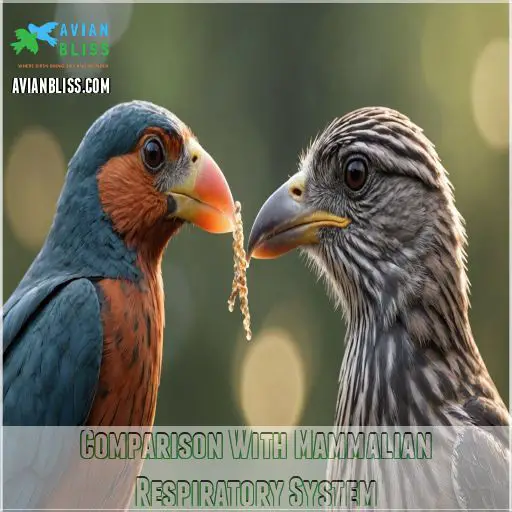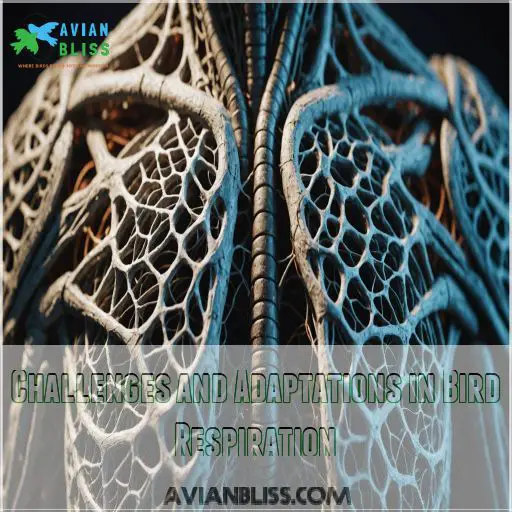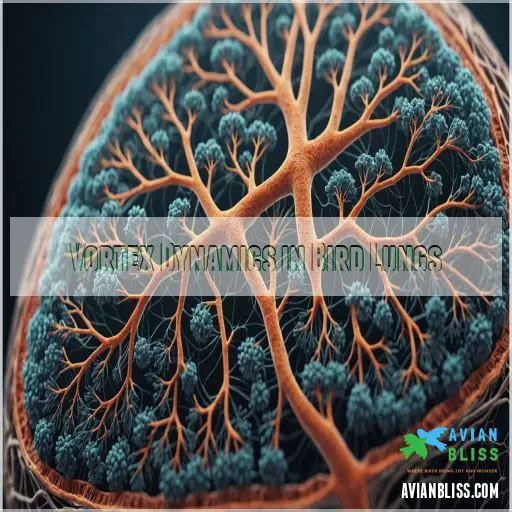This site is supported by our readers. We may earn a commission, at no cost to you, if you purchase through links.

Those air sacs act as bellows, keeping a constant supply of fresh air flowing through their lungs. And get this – birds don’t even have a diaphragm! Their powerful rib and sternum muscles do all the work. It’s a two-step dance that keeps those feathered friends soaring effortlessly.
Pretty cool, right? Wait till you see how they handle high altitudes…
Table Of Contents
- Key Takeaways
- Unique Bird Respiratory System
- How Birds Breathe Through Their Beaks
- Bird Lungs and Air Sacs Design
- Breathing Mechanism in Birds
- Comparison With Mammalian Respiratory System
- Challenges and Adaptations in Bird Respiration
- Similarities With Crocodilian Respiratory System
- Vortex Dynamics in Bird Lungs
- Evolutionary Advantages of Bird Respiratory System
- Future Research and Implications
- Frequently Asked Questions (FAQs)
- Do birds breathe with lungs or gills?
- How do birds breathe through their beaks?
- Do birds get out of breath from flying?
- Can a bird breath underwater?
- How do birds adjust breathing in cold weather?
- Can birds suffer from respiratory illnesses?
- How does bird respiration change during rest?
- What are the largest air sacs in birds?
- How do aquatic birds manage breathing underwater?
- Conclusion
Key Takeaways
- You’ll be amazed by birds’ ingenious one-way airflow system — it’s like a high-speed train delivering oxygen straight to the engine! Their air sacs act as bellows, keeping a constant supply of fresh air flowing through their lungs, all without a diaphragm.
- Birds’ unique respiratory system is a marvel of evolution, perfectly adapted to fuel their high-flying, high-energy lifestyles. Their wing design, muscle adaptations, and supercharged metabolism work in harmony to keep these feathered wonders soaring effortlessly.
- Studying how birds and other animals breathe can provide valuable insights for improving human health. Exploring evolutionary adaptations in animal lungs may uncover innovative solutions for oxygen therapy and lung disease management.
- Birds don’t just casually inhale and exhale; their lungs are like finely-tuned vortex machines! Tiny tornado-like airflows in their loop-shaped airways and air sacs help maintain a constant, one-way airflow, much like valves controlling fluid flow in mechanical systems.
Unique Bird Respiratory System
You may not realize it, but birds breathe in a way that would put our own lungs to shame, using a remarkable respiratory system that’s as efficient as a well-oiled machine.
With their high metabolic rates, they’ve evolved to harness the power of air sacs and unidirectional airflow to guarantee they never run out of breath, even on their most daring flight adventures.
High Metabolic Rates and Energy Needs
As birds are constantly on the move, they require a lot of energy to fuel their high-octane lifestyles. To meet these demands, birds favor protein and fat-rich diets that pack a serious punch.
Their bodies are finely tuned machines, optimized for:
- Rapid metabolism to generate heat and power
- Efficient nutrient absorption to extract maximum energy
- Streamlined physiology to minimize weight and maximize agility
Efficient Oxygen Supply Through Air Sacs
Birds breathe like maestros in a concert, synchronizing oxygen delivery with energy needs. Their unique air sacs and static lungs help them efficiently transport oxygen for their high-flying lifestyle.
Unlike humans’ tidal breathing, birds utilize intercostal muscles for a one-way unidirectional flow, eliminating stale air. So, how do birds breathe? Imagine managing a team of air sacs like bouncers at a club—dynamic yet efficient.
| Concept | Explanation |
|---|---|
| Air Sac Function | Acts like bellows directing air flow |
| Bird Respiration | Two breaths per cycle makes sure fresh air constantly |
| Lung Efficiency | Static lungs with a one-way air flow |
| Flight Adaptations | Enables birds to meet high oxygen demand during flight |
Unidirectional Airflow and Constant Oxygenation
Imagine breathing as efficiently as a bird, with unidirectional airflow delivering constant oxygenation.
Their lungs work like a well-oiled machine, featuring air sac function and vortex dynamics for seamless avian respiration.
Bird lung efficiency outshines many mammals, driven by evolutionary adaptations for high-energy lifestyles.
It’s like having your cake and eating it too—flight-ready and oxygen-rich.
How Birds Breathe Through Their Beaks
In terms of breathing, birds have a fascinating system that makes use of both beaks and nostrils, with the trachea acting as their primary air highway.
Birds can’t pant like dogs, they might just give you a quizzical look with their mouths open—an amusing gesture to cool down on a hot day!
Trachea and Nostrils as Air Entry Points
You may not realize it, but birds have a unique respiratory system that allows them to take in air through their nostrils and trachea.
This rigid, cartilage-ringed tube is the gateway for oxygen-rich air to enter the lungs.
Breathe easy, feathered friends – your beaks play a key role in this efficient airflow!
Role of Mouth in Regulating Body Temperature
Although the trachea and nostrils are primary air entry points, the avian beak doubles as a cooling mechanism too.
Picture panting like a dog—birds use mouth-breathing for heat dissipation through avian thermoregulation.
Some species even perform gular flutter, rapidly vibrating the throat to fan themselves. It’s a bit like fanning your face with a favorite book on a summer’s day!
Differences From Mammalian Breathing Mechanisms
While birds manage temperature with their mouths, their breathing lacks the mammalian diaphragm.
Instead, air sac functions shine in supplying oxygen with unidirectional airflow versus our tidal approach.
Bird lung structures, shaped by evolutionary adaptations, resemble a well-tailored suit—efficiency over bulk. Here, fresh air constantly flows through, keeping oxygen availability and energy topped up like a hummingbird on espresso.
Bird Lungs and Air Sacs Design
When you look at how birds breathe, their lungs and air sacs work like a smart team to make sure they get enough oxygen.
With air flowing in one direction through loop-shaped airways and parabronchi, birds maintain a constant oxygen supply, keeping them ready to soar while making us wonder if they secretly inspire the efficiency of your morning coffee machine!
Loop-Shaped Airways and Air Sacs Structure
The intricate design of bird lungs is a marvel of evolution. These avian wonders feature a network of loop-shaped airways and air sacs that work in harmony. The air sacs act as bellows, directing the flow of air through the lungs.
This unique structure enables:
- Efficient gas exchange
- Unidirectional airflow
- Constant oxygen supply
- Adaptations for high-energy lifestyles
Unidirectional Airflow Through Parabronchi
Let’s explore the intricate world of bird lungs! Parabronchi structure allows air to flow smoothly in one direction, creating efficient vortex motions.
This unique design, resulting from fantastic bird lung evolution, works wonders for gas exchange.
Unlike tidal systems, it keeps oxygen flowing freely—no hiccups! Birds’ unidirectional breathing even rivals crocodilian respiratory prowess, securing their title as nature’s flight champions.
Importance of Air Sacs in Maintaining Oxygen Supply
Imagine tiny backpacks filled with air, supporting your every breath. That’s what air sacs do for birds, ensuring they never run out of oxygen.
These wonders:
- Enhance air sac capacity for breathing.
- Maintain pressure, allowing constant airflow.
- Support rapid energy demands.
- Evolved uniquely, to outfly predators.
Bird life is amazing!
Breathing Mechanism in Birds
Discover how birds manage to breathe efficiently without a diaphragm, relying on their powerful rib and sternum muscles to move air through their lungs in a fascinating two-stage process.
From the first breath to the final exhale, their bodies expertly handle airflow just like an efficient multitasker would manage a crowded schedule.
Two-Stage Breathing Process
Birds don’t just gulp down air like us – their breathing is a well-choreographed two-step dance!
First, fresh air rushes into the larger posterior air sacs during inhalation.
Then, that air flows through the lungs, while stale air from the anterior sacs gets expelled.
This back-and-forth keeps their engines revving high.
Inhalation and Exhalation Process in Birds
In the intricate world of avian respiration, air flows in just one direction through bird lungs.
When inhaling, fresh air fills the posterior air sacs, while exhaling pushes it through the parabronchi.
This breathing cycle makes for efficient oxygen exchange.
With every breath, intricate airflow direction keeps lung pressure steady, showcasing the elegant process that contrasts mammalian breathing.
Role of Muscles in Assisting Breathing
You know, it’s like the bird’s rib cage and sternum have their own little gym routine! Muscles play a key role in breathing:
- Contraction: Expands air sacs efficiently.
- Relaxation: Compresses sacs for exhalation.
- Air Sac Control: Important for respiratory efficiency.
- Synchronized Movement: Achieves unidirectional airflow.
This teamwork helps birds breathe easy, even in thin air.
Comparison With Mammalian Respiratory System
Think birds have the same type of lungs as mammals? Think again!
While mammals like us waltz through life with tidal breathing, birds have a one-way air traffic system in their lungs that’s as efficient as a well-oiled machine, giving them the edge in race car-like endurance and oxygen supply.
Differences in Lung Structure and Function
Quite simply, bird lungs are built differently than mammalian lungs.
While we humans rely on tidal breathing, birds have a unique network of air sacs that create a one-way airflow.
This unidirectional system provides a constant supply of oxygen, fueling their high-energy lifestyles.
Let’s take a closer look at the key differences:
| Feature | Bird Lungs | Mammalian Lungs |
|---|---|---|
| Structure | Loop-shaped airways and air sacs | Branching bronchi and alveoli |
| Airflow | Unidirectional | Tidal |
| Gas Exchange | Highly efficient | Less efficient |
| Oxygen Capacity | Excellent for high-intensity activities | Sufficient for moderate activities |
Unidirectional Airflow in Birds Vs. Tidal Breathing in Mammals
Birds soar with unidirectional airflow, their lungs resembling a super-efficient highway where air flows in one direction only.
Meanwhile, mammals employ tidal breathing, akin to a crowded elevator where air goes in and out the same way.
This evolutionary history spotlights how lung structure reflects energy efficiency, meeting each creature’s respiration needs and altitude adaptation with humor and finesse!
Advantages and Disadvantages of Each System
A bird’s respiratory system is like a high-speed train: efficient and purposeful, with a four-step breathing cycle.
Mammals, meanwhile, take the scenic route.
Here’s the breakdown:
- Efficiency: Birds’ unidirectional airflow maximizes oxygen, vital for flight.
- Evolution: This design traces back to dinosaurs and shares traits with crocodiles.
- Downside?: Mammals’ tidal breathing allows greater flexibility and strong adaptation to varied environments.
Challenges and Adaptations in Bird Respiration
You might be surprised to learn that birds have mastered the art of breathing even in the thin air of high altitudes.
Their lung design doesn’t just keep them soaring; it’s like nature’s version of an energy drink, fueling them with the oxygen needed for those epic flights!
High-Altitude Flight and Oxygen Requirements
As birds soar to dizzying heights, their bodies must adapt to the thinning oxygen.
Imagine the challenge – with each flap of their wings, they battle the effects of hypoxia.
But these feathered flyers have evolved ingenious strategies, like expanding their air sacs, to maintain a steady oxygen supply even in the rarified air of high altitudes.
Efficient Gas Exchange in Bird Lungs
Soaring high requires savvy oxygen transport strategies with bird lungs.
Their efficiency centers around constant airflow, courtesy of unique structures:
- Parabronchi allow for seamless air passage.
- Nine air sacs optimize fresh air flow.
- Unidirectional flow minimizes wasted breaths.
- Tiny capillaries facilitate direct gas exchange.
Understanding bird lung evolution might just blow your mind!
Adaptations for Maintaining Aerobic Capacity
You’re probably wondering how birds keep oxygen flowing for high-altitude flight.
It’s like they’ve turbocharged lungs.
Their air sac size and muscle efficiency enhance flight efficiency, while metabolism regulation keeps their engines humming.
Imagine a marathon runner with wings—high-altitude adaptations allow them to breathe easy, no gasping needed.
Thanks to these nifty tricks, they’re the sprinters of the sky!
Similarities With Crocodilian Respiratory System
You’re about to explore the surprising respiratory similarities between birds and their less feathery relatives, crocodiles.
It’s fascinating how both share a breathing technique inherited from a common dinosaur ancestor, though with differences reflecting their unique lifestyles.
Shared Common Ancestor and Evolutionary Connections
Birds and crocodiles share a fascinating evolutionary connection – they both descend from the mighty dinosaurs!
This ancient ancestry explains the similarities in their respiratory systems, which have adapted over millions of years to support their unique lifestyles.
Exploring these shared roots provides valuable insights into the incredible diversity of life on our planet.
Unidirectional Airflow in Both Birds and Crocodiles
Traced back to dinosaurs, birds and crocodiles boast similar unidirectional airflow.
This shared evolutionary history fuels:
- Physiological adaptations for diverse lifestyles
- Efficient oxygen uptake for active lives
This shared evolutionary history also has implications for:
- Potential engineering applications inspired by unique flow dynamics
- Conservation implications emphasizing interconnectedness
- Insight into future research on animal breathing
Their breath-taking breathing system: a marvel of nature and evolution!
Differences in Respiratory System Structure and Function
Both birds and crocodiles exhibit a unidirectional airflow system, but their breathing structures differ like apples and oranges. Bird lung development features air sacs enhancing respiration efficiency, while crocodile adaptations rely on locules instead of air sacs.
Mammalian vs. bird breathing contrasts sharply as birds utilize unique air sac evolution for constant oxygen flow, unlike mammals’ tidal system.
Vortex Dynamics in Bird Lungs
Birds don’t just casually inhale and exhale; their lungs are like finely-tuned vortex machines!
Recent studies have shown that tiny, tornado-like airflows in their lungs help maintain a constant, one-way airflow, much like a perpetual breeze party in those avian chests.
Discovery of Tornado-Like Airflows in Bird Lungs
Remarkably, researchers have uncovered the secret behind birds’ efficient breathing – tiny tornado-like airflows, or vortices, arise inside their loop-shaped airways and air sacs.
This discovery could inspire innovative engineering solutions, as these vortices create a one-way air current, much like valves controlling fluid flow in mechanical systems.
Role of Vortices in Maintaining Unidirectional Airflow
After exploring tornado-like airflows in bird lungs, picture the vortex formation as nature’s brilliant design for maximizing respiratory efficiency.
These small, swirling currents dance through avian airways, ensuring unidirectional airflow dynamics.
It’s like each breath is on a nature-made conveyor belt, constantly moving.
Such an elegant system highlights bird lung evolution but also a respiratory efficiency worthy of admiration.
Implications for Engineering and Biomedical Applications
Vortex dynamics in bird lungs have opened the door to innovations in engineering and medicine. Imagine applying nature’s wisdom to improve our world. You could:
- Design more efficient ventilators inspired by biomimicry.
- Revolutionize fluid dynamics in medical devices.
- Create biomaterials mimicking bird lung structures.
- Enhance environment-friendly fluid systems.
- Develop new methods for air filtration.
Evolutionary Advantages of Bird Respiratory System
You might think birds have superpowers when you learn how their unique respiratory system works to support high-energy flight.
With one-way airflow ensuring efficient oxygen supply, these feathered creatures make flying look as easy as a stroll in the park, minus the fear of flying into a lamppost!
Adaptations for Flight and High-Energy Lifestyle
Birds’ unique respiratory system is a marvel of evolution, perfectly adapted to fuel their high-flying, high-energy lifestyles.
Their wing design, muscle adaptations, and supercharged metabolism work in harmony to keep these feathered wonders soaring effortlessly.
It’s no wonder birds seem to defy gravity – their lungs are built for the challenge!
Efficient Oxygen Supply and Aerobic Capacity
Zooming through the skies requires serious energy! Thankfully, birds have a respiratory system that’s as efficient as a Swiss watch, supplying oxygen like there’s no tomorrow. This exceptional efficiency supports their high-energy lifestyle and flight adaptations.
Their unique design also leaves crocodiles playing catch-up, providing superior oxygen transport even during high-altitude breathing.
Birds really take breathing to a whole new level!
Unique Features of Bird Respiratory System
You’ll find the bird’s respiratory system is an evolutionary magician without pulling any rabbits out of hats. Air sac functions provide gobsmacking respiratory efficiency, ensuring peak performance with every breath.
Bird lung evolution showcases breathing and flight harmony, a science fiction-worthy tale.
Bird respiration adaptations keep these sky acrobats energized. It’s like nature’s ultimate marathon, happening right under their feathers!
Future Research and Implications
If you think birds have cooler lungs than you do, you’re onto something—this unique respiratory system could revolutionize human health research and engineering.
So, flap your way into the future as studies on birds and their crocodilian cousins continue to inspire innovations!
Studying Animal Respiration for Human Health Insights
Studying how birds and other animals breathe can provide valuable insights for improving human health.
For instance, understanding how crocodiles can hold their breath for extended periods could inspire new strategies for treating respiratory illnesses. Exploring evolutionary adaptations in animal lungs may also uncover innovative solutions for oxygen therapy and lung disease management.
- Breath-holding abilities in aquatic animals
- Unidirectional airflow in avian and reptilian lungs
- Efficient gas exchange mechanisms in diverse species
- Adaptations for high-altitude and high-activity lifestyles
- Insights into respiratory system function and dysfunction
Potential Applications in Biomedical and Engineering Fields
Imagine this: Birds’ incredible respiratory system design might soon inspire bio-inspired pumps and revolutionize lung disease treatment.
Imagine engineers drawing from their oxygen delivery efficiency, creating devices as reliable as your favorite morning coffee.
Biomimicry in engineering dances its way toward innovations, showing how even a bird’s breath can change our world.
Now that’s the kind of lung power we need!
Further Research Into Bird and Crocodilian Respiratory Systems
Diving into the mysteries of respiratory evolution, exploring bird lung mechanics and crocodilian adaptations is like a treasure hunt for life’s hidden secrets.
Evolutionary pressures have driven unique adaptations, making gas exchange efficiency a marvel of nature.
By understanding respiratory system evolution in birds and crocodilians, we might uncover new strategies for health and innovation.
Who knew breathing could hold solutions?
Frequently Asked Questions (FAQs)
Do birds breathe with lungs or gills?
Birds breathe with lungs, not gills.
Their efficient respiratory system includes air sacs enabling twice the oxygen exchange compared to a similar-sized mammal lung.
It’s like having a supercharger for flight, meeting energy demands effortlessly.
How do birds breathe through their beaks?
When you breathe in through your beak, air flows through the nares, travels down the trachea to the air sacs and lungs.
This allows efficient oxygen exchange needed for flight and high metabolism.
Always fascinating!
Do birds get out of breath from flying?
You won’t find birds gasping for air mid-flight – their remarkable respiratory system guarantees a steady oxygen supply, even during intense aerial maneuvers.
This unidirectional airflow keeps them soaring effortlessly, never out of breath.
Can a bird breath underwater?
A bird might dive for a snack, but keeping its head above water is key!
Without gills, it can’t breathe underwater.
It’s like trying to fly with fins—just not in the avian playbook!
How do birds adjust breathing in cold weather?
Imagine bird lungs as a well-oiled machine; they adjust perfectly in cold weather.
By increasing their breath rate slightly and fluffing feathers to trap heat,
they conserve warmth and maintain efficient oxygen intake.
Can birds suffer from respiratory illnesses?
Birds can indeed suffer from respiratory illnesses, such as aspergillosis, which can cause difficulty breathing, coughing, and loss of appetite.
Efficient diagnosis and treatment are essential for managing these conditions to keep your feathered friends healthy (Source).
How does bird respiration change during rest?
At rest, a bird’s respiratory rate slows down to conserve energy.
Their lungs remain constantly inflated by the air sacs, which act like bellows to efficiently supply oxygen even when the bird is inactive. (Source)
What are the largest air sacs in birds?
You’re in for a surprise: the largest air sacs in birds are the posterior air sacs.
They’re like balloon-like superheroes, positioned at the back, providing the extra oomph needed for birds’ high-flying adventures (Source).
How do aquatic birds manage breathing underwater?
Aquatic birds can’t breathe underwater; they hold their breath while submerged.
They store oxygen in their air sacs, slow metabolism, and redirect blood to critical organs.
So, they dive deeply and emerge like underwater ninjas.
Conclusion
Absolutely mind-boggling, isn’t it? Birds have evolved a respiratory system that’s practically a superpower, allowing them to breathe efficiently without the aid of a diaphragm.
By understanding how birds breathe, you witness the marvel of nature’s engineering: a unidirectional airflow supported by air sacs and strong muscles.
This system enables them to soar and conquer heights, offering incredible insights into nature’s adaptability and efficiency, potentially even opening up new possibilities for human respiratory challenges.
Fly on, feathered engineers!













